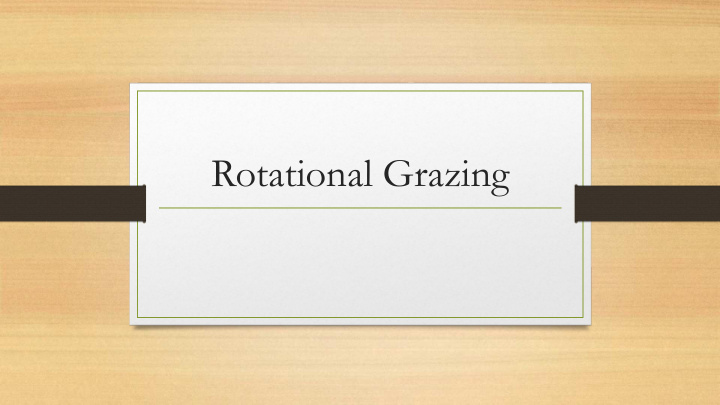



Rotational Grazing
Spring • SPRING: When grass first greens up in the spring, it’s tempting to send the cows out to graze. But allowing the grass to get some good growth, then dividing the pasture up into smaller pieces and moving the cattle quickly through those paddocks will benefit the pasture all year. In the spring, it’s even more important to let as much leaf behind as possible so the plant can build reserves in its roots. Good root reserves lead to hardier plants and more grass!
Spring/Summer • SPRING/SUMMER: This grass has been grazed, believe it or not! The cows are only allowed in the paddock long enough to take a bite of each bunch of grass. There is plenty of leaf left to collect sunlight and make energy for the plant to grow back thick and lush. This quick rotational movement is especially important in the spring, when plants are gearing up for the summer.
Summer SUMMER: A good mix of grasses and forbs make • the best pasture! What would commonly be defined as a weed on a farm can provide a nutrient or mineral that the livestock need for a balanced diet. It’s always entertaining to watch the cows go into a new paddock to see what they eat first. They love curly dock! They will eat hemp dogbane, too! A lot of “weeds” have high protein content, which cows need for good growth. Diversity comes naturally, in the form of different grasses, clovers, plantains, dandelions, etc. Adapting this management means we don’t spray our pastures with chemicals to control weeds.
Summer When livestock are out on pasture and have access to the whole field all the time, they eat the • plants that they like first. After a few days, those plants start to grow again, just like your yard after you mow it. The plant is trying to get its “solar panel” back up in the form of a leaf so it can gather energy from the sun for growth. The livestock really like the short, tender, new part of the plant that is trying to grow again, so they bite it off again….and again……and again. Eventually, the plant is so weak from lack of sunlight that it dies. What is left behind is bare ground or plants that the cows didn’t want to eat. In most cases, the remaining plants don’t offer much nutrition for them. The idea behind a rotational grazing system is that grass can’t be cut every day without eventually dying. In a rotational grazing system, the big pasture fields are divided up into pieces with some permanent and temporary fences. In this system, the farmer opens one of the fences to a new piece of the pasture each day, sometimes twice a day, to let the cows in. They eat the grass in that little piece and are moved into a new piece the next day. Meanwhile, the other pieces of pasture are not grazed, so the grass is able to grow back completely. When it has grown back, the cows have grazed their way across the field and can be brought back to the beginning again. The grass remains strong and thick, the ground is covered and protected, the soil is healthy and fertile, and the cows always have a lot of grass to eat.
Summer • SUMMER: Summer annuals are plants that love the heat of summer when cool season pasture plants slow down. Summer annuals like sudan grass or sorghum sudan can be sown into existing pasture or into a field that was cropped. These heat tolerant plants allow help to keep the buffet stocked all summer.
Late Summer LATE SUMMER: Cover crops are great for • pasture too! Cover crops can be planted planted after summer annuals are grazed in late summer. The summer annuals will not survive after a frost, and the ground will be unprotected if nothing is planted there for the winter. Cover crops grow enough in the fall to cover the soil over the winter. They improve the soil, capture nutrients that would otherwise be lost, keep the soil from drying out, reduce erosion from wind and rain, and the cows love grazing on them! Anything that isn’t eaten is trampled down. This means it’s added to the soil as organic matter and seed, which improves pasture yield.
Fall/Winter • FALL/WINTER: This farmer's goal is to be able to graze cows every day of the year. This requires stockpiling, or allowing certain fields to grow all summer without being hayed or grazed. The grass is these fields can then be grazed in the winter.
Fall/Winter • FALL/WINTER: By practicing stockpiling, this farmer is able to extend the grazing season. Here, cows are feeding on stockpiled forage in December.
Winter • WINTER: Often seen as “wasting” hay, rolling out baled hay in the winter is very beneficial. It helps distribute organic matter, nutrients, and seed over resting pastures. Increased organic matter and evenly distributed nutrients help increase pasture yield during the growing season, which means more grass for the cows to eat.
Winter • WINTER: Rolling hay in the winter season is one way to keep the cows out in their natural environment, improving herd health.
Next Spring • NEXT SPRING: By following the conservation practices for rotational grazing and taking care of soil and pasture health, the farmer's pastures will be lush, evenly grazed, and mostly without bare spots or invasive weed issues.
Recommend
More recommend